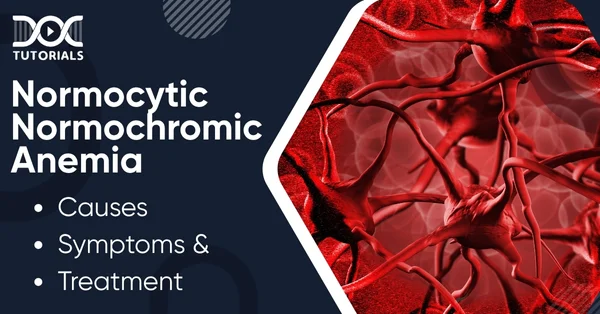Normocytic Normochromic Anaemia: Causes, Symptoms, Diagnosis and Treatment

Normocytic normochromic anaemia is an anaemia in which red blood cells (RBCs) are of normal size (normocytic) and colour (normochromic), but their count is less than desired to deliver enough oxygen throughout the body. Even though they seem to be normal under the microscope, this anaemia is usually a complication of secondary chronic diseases and not an intrinsic blood defect.
Recognising the causes, signs, and treatment options for normocytic normochromic anaemia is key to managing it early and effectively. For those in the healthcare field—or aspiring medical professionals—understanding this condition in depth is an essential step in developing diagnostic skills and improving patient outcomes.
Curious to learn more? Let’s dive in.
What is Normocytic Normochromic Anaemia?
This type of anaemia is defined by a reduction in red blood cell count, but the cells are within a standard size and typical haemoglobin level. In brief, the red cells are normal, but there simply aren’t enough of them to facilitate adequate oxygen supply throughout the body.
Alternatively, microcytic anaemia is another type of anaemia that includes red blood cells that are smaller than usual, typically present in conditions such as iron deficiency. At the opposite end of the size spectrum is macrocytic anaemia, which includes red blood cells larger than usual, a frequent indicator of conditions such as vitamin B12 or folate deficiency.
Understanding the size and haemoglobin content of red blood cells can give healthcare providers essential clues about what’s causing the anaemia, helping tailor the right treatment plan for each patient.
What are the Causes of Normocytic Normochromic Anaemia?
Normocytic normochromic anaemia typically occurs due to chronic disease or chronic inflammation. Some common medical conditions that lead to this type of anaemia are:
- Tuberculosis or hepatitis B or C, HIV, lung abscesses, bacterial endocarditis, tuberculosis, or osteomyelitis
- Thyroid inflammation (thyroiditis)
- Chronic kidney disease
- Liver diseases
- Diabetes mellitus
- Heart failure
- Obesity complications
- Lupus, Crohn’s disease, or rheumatoid arthritis (autoimmune conditions)
- Vasculitis, which is inflammation of blood vessels
- Sarcoidosis, which involves the lungs and lymph system
- Inflammatory bowel diseases like ulcerative colitis
- Bone marrow disorders
- Some cancers
Besides chronic diseases, there are other possible risk factors, such as:
- Abnormal menstrual bleeding
- Side effects of some medications
- Pregnancy anaemia
- Certain gastrointestinal surgeries that inhibit nutrient uptake
- Sudden or severe blood loss
This type of anaemia also occurs in some people at birth. Inheritable forms of normocytic anaemia are common in people with inherited illnesses such as sickle cell disease.
What are the Symptoms of Normocytic Normochromic Anaemia?
The normocytic normochromic symptoms typically show up gradually and are indistinguishable from other anaemias. Most individuals do not even know they have the condition until their haemoglobin becomes extremely low, typically below 7 grams per deciliter (g/dL).
Typical symptoms might be:
- Chronic fatigue or tiredness
- Muscle weakness
- Dizziness or light-headedness
- Painful leg syndrome (Restless Leg Syndrome)
- Chest tightness or pain
- Reduced physical endurance
Since this form of anaemia often occurs with a chronic illness, it is challenging to separate anaemia symptoms from the disease.
How is Normocytic Normochromic Anaemia Diagnosed?
Diagnosis begins typically with a complete blood count (CBC) and discloses low haemoglobin and red blood cell counts. The physician might also examine a peripheral blood smear to narrow down the cause and perform other laboratory tests.
A reticulocyte count will also give you a clue about whether or not your bone marrow is properly making new red blood cells. Depending on what is found, you can be referred to a haematologist (blood physician) or an internal medicine doctor for further study and treatment.
What are the Treatment Options for Normocytic Anaemia?
This medical condition is treated by addressing the original cause and assisting the body in returning to normal levels of healthy red blood cells. Thus, normocytic normochromic anaemia treatment must be tailored to the individual and may include one or more of the following actions:
- Blood Transfusions: In urgent situations in which the count of red blood cells drops critically low, a transfusion can be given. It is a quick injection of RBCs into the system, particularly in cases of trauma or intracorporeal bleeding.
- Surgery: In the case of heavy bleeding due to injury or internal bleeding leading to anaemia, surgery would be needed to inhibit further loss of red cells and to prevent ongoing blood loss.
- Erythropoietin Treatment: The synthetic hormone mimics the kidney-secreted natural hormone that stimulates the production of red blood cells in bone marrow. It is beneficial for cancer, anaemia, or chronic kidney disease patients.
- Management of the Underlying Disease: If anaemia is due to a chronic cause, i.e., heart failure, liver disease, diabetes, kidney disease, or cancer, management of the underlying disease can enhance the level of RBCs and the symptoms in general over a period of time.
Even when symptoms are mild or absent, early treatment of anaemia is critical. Untreated anaemia can impact your recovery from other medical conditions and weaken your body’s ability to heal.
FAQs About Normocytic Normochromic Anaemia
- What is severe normocytic normochromic anaemia?
It refers to a condition in which red blood cells are of normal size and colour but insufficient in number. In most cases, it is caused by chronic diseases, but in exceptional situations, it may be associated with primary blood diseases.
- How can you prevent normocytic normochromic anaemia?
Prevention relies on controlling the fundamental underlying disease. Treatment of chronic disease generally keeps red blood cell counts within normal parameters. Supplements such as iron, folate, or vitamin B12 can be beneficial in some instances.
- Is normocytic normochromic anaemia curable?
Yes, if it is caused by a temporary problem such as trauma or acute bleeding. Treatment, including transfusions and management of the underlying condition, can result in complete recovery.
- Is normocytic normochromic anaemia genetic?
In some instances, this type of anaemia is inherited. While often secondary to other conditions, it may also result from inherited disorders like sickle cell disease.
- Can inflammation cause normochromic anaemia?
Yes. Chronic inflammatory diseases disrupt the production of red blood cells, leading to what is referred to as anaemia of chronic disease—a frequent normocytic normochromic appearance.
Conclusion
Normocytic normochromic anaemia is a common form of anaemia where red blood cells are normal in size and colour but reduced in number. It usually develops due to blood loss, chronic disease, or insufficient red cell formation. With timely treatment of the underlying cause, symptoms typically improve, and red blood cell levels can normalise.
For every NEET PG aspirant, mastering topics like this and other related conditions is crucial not only for covering their syllabus, but also for accurate diagnosis as future medical professionals. In this regard, DocTutorials supports your journey with expert video lectures, Quick Revision Programs (QRPs), and high-yield study notes—designed to help you excel in exams and real-world practice. Check out our NEET PG courses today and boost your medical prep!
Latest Blogs
-

NEET PG Exam 2025- Date, Pattern, Marking Scheme, Subject Wise Weightage, and Exam Mode
NEET PG Exam 2025 is the ultimate gateway for medical graduates aspiring to pursue postgraduate courses in medicine, including MD,…
-

INI CET Exam 2025: Your Roadmap to Success – Key Topics, Strategies, and Lessons from Last Year’s Papers
The INI CET exam is more than just a test; it’s a significant milestone for many medical students aiming to…
-

INI CET Exam Success: Previous Year Question Papers & Ultimate Guide – INI CET PYQ
One can feel overwhelmed while preparing for the INI CET (Institute of National Importance Combined Entrance Test). A vast syllabus,…




